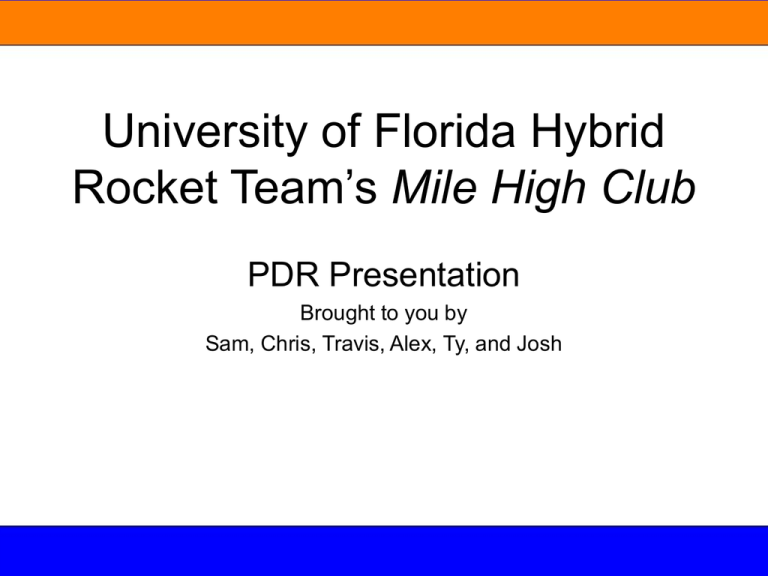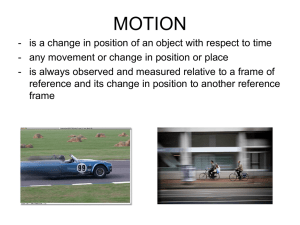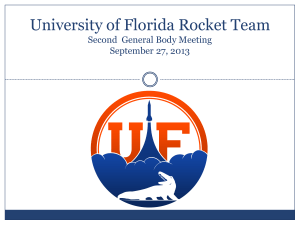Presentation
advertisement

University of Florida Hybrid Rocket Team’s Mile High Club PDR Presentation Brought to you by Sam, Chris, Travis, Alex, Ty, and Josh Major Change Since Proposal • • • Change of Material: Only basalt fiber and epoxy will be used to construct the body tube of the rocket, instead of the four different types of composite materials mentioned in the proposal. Consequentially Only strain measurements of a basalt body tube will be measured. Notes on Basalt: 1. Limited use in U.S. aerospace applications 2. Slightly higher elastic modulus than fiberglass 3. Much higher operating temperature than fiberglass 4. Slightly denser than fiberglass 5. About the same cost as fiberglass Vehicle Design Vehicle Dimensions Flight Plan (Vehicle Perspective) Launch to Apogee Apogee to Chute Deployment Chute Deployment to Ground Motor • Primary motor J1999 • Possible Alternates K1100, J800 Thrust Curve Vehicle Materials/Manufacturing • Airframe Construction Vehicle Materials/Manufacturing • Fins • Tip to Tip Reinforcement • http://www.youtube.com/watch?v=Dd_tN5NNPM 1:05 Recovery System Design Layout • • • • Ejection Charges Recovery wadding Parachute Parachute Chords Specifics Pyrodex based ejection charges Recovery wadding: to be determined through testing Parachute chord: to be determined through testing Parachute: 27” X-Form for deployed terminal velocity of about 10 mph Mission Performance Predictions • Used RockSim to determine the weight of the rocket to reach slightly above 5,280 and also stay underneath Mach 1. • Simulations: Apogee at 5,870 feet. Max Velocity at 670 ft/sec • More simulations will be run before and after test launches to optimize performance Vehicle Safety and Stability • • Stability Margin is 1.37 Testing Dates: – January 6th-13th : Initial Recovery System Testing – January 16th: Subscale Launch Test – March 6th: Full scale Launch Test Initial Recovery System Testing Ejection Charge Initial estimate of powder needed made using charge calculator Charge made to estimated specs testing in test rig. Observe and record results. Repeat as necessary until desired ejection is acheived. Subscale and Full scale Tests • The Subscale Launch Test will test a half scale model of the full scale rocket. It will use a G125 motor from Aerotech. • Primary objectives: to assess the functionality of the recovery system, the accelerometers and pressure system, and the stability of the rocket design. • The Full scale Launch Test will test the actual rocket to be used in the competition. • Primary objectives: To check that all systems are correctly functioning, and if necessary, which systems need to be altered to achieve the desired function. To check if redesigning parameters of the rocket, such as the weight, is necessary. Payload • • • 20 strain gages located in the payload section of the rocket Will measure both the lateral strain and axial strain of the basalt fiber body tube as a function of distance along the body tube and time of experiment. Hopefully the data acquired from this experiment will help in the optimization of rocket airframe design. Drag Force Drag Force Payload test section Thrust Thrust Payload • RockSim simulation of drag force versus time • We expect our strain measurements to mirror the shape of the drag force graph below Payload Integration • • The strain gages will be located in the payload section of the body tube They will be isolated from both ejection charges with solid couplers Inner tube contains altimeters, data logger, accelerometers, and other electronics Strain gages located on the inside of the body tube Payload Testing • • • By February 20, 2010 Elastic behavior of basalt fiber will be analyzed with load cells and strain gages in the Mechanics of Materials Laboratory at UF. A small test section of basalt fiber will be constructed and brought into the lab to measure the strain experienced under axial compressive loading. Omega corner rosettes Goals • Implement strain gauges • Build data logger • Fly Rocket Proposed Rocket Layout • Removable electronics module • Survivable at high g's during launch Onboard Controller Prelaunch • Rocket will talk with computer and verify link • Rocket will wait impatiently for the launch • Rocket will record to SD card all channels to SD card at 1Hz • Rocket will send all data to base station at 1Hz Launch to Apogee • Rocket will record all channels to SD card at high data rate 100Hz • Rocket will send data to the base station at 1 Hz • Rocket may turn yellow Apogee • Rocket will sense apogee to deploy chutes according to preset altitude/time constraints • Rocket will continue to log data Landing • If still intact and in range the rocket will log data at 1Hz • Rocket will continually send GPS location • Rocket will transmit flight log to ground station for processing Conclusion • More analysis to be done on strain calculations and how our data can benefit the design of rocket airframes • Parts for initial recovery system testing and subscale rocket construction need to be ordered as soon as possible











